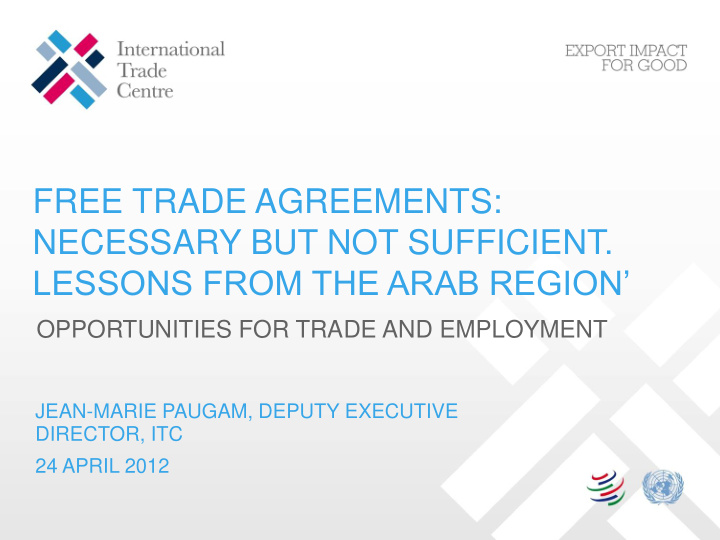



FREE TRADE AGREEMENTS: NECESSARY BUT NOT SUFFICIENT. LESSONS FROM THE ARAB REGION’ OPPORTUNITIES FOR TRADE AND EMPLOYMENT JEAN-MARIE PAUGAM, DEPUTY EXECUTIVE DIRECTOR, ITC 24 APRIL 2012
2 Intra-regional trade shares around the world (excl. oil) EU 60% ASEAN 23% ALADI 17% LAS 11% SADC 10% 0% 10% 20% 30% 40% 50% 60% 70% ALADI: Asociación Latinoamericana de Integración
3 LAS trade partners (excl. oil) OECD 49% DCs 31% LAS 11% RoW 8% LDCs 1% 0% 10% 20% 30% 40% 50% 60% DCs Developing Countries RoW Rest of the World
4 Evolution of LAS’ trade with the EU, LAS and the Rest of the World (excl. oil) 700 500 300 100 100 300 500 700 2010 2009 2008 2007 2006 2005 2004 2003 2002 2001 2000 1999 1998 1997 Import Export 1996 1995 Billions of US$ EU LAS RoW
5 Evolution of LAS shares in total supply of LAS and Rest of the World (excl. oil)
6 Trade complementarity of different country groups (incl. oil) LAS exports LAS OECD Developing LDCs to… countries Trade Comple- mentarity 29 34 35 26 Index (TCI) Actual export 6% 44% 26% 1% share TCI = 100 complete overlap of trade structures TCI = 0 no overlap
7 Trade agreements involving LAS members by 2012
8 Average tariffs vary among LAS countries Country grouping Weighted average tariffs Comoros, Djibouti, Mauritania 10-21% Algeria, Egypt, Morocco, Sudan and 1-2% Yemen Bahrain, Jordan, Kuwait, Lebanon, Libya, 0-0.3% Oman, Qatar, Syria, Tunisia and United Arab Emirates Weighted average tariffs have been weighted according to trade values
9 Aggregate survey results for LAS countries (1/2) Share of burdensome NTMs and exports across trading partners
10 Aggregate survey results for LAS countries (2/2) Agricultural exports: types of burdensome NTMs applied by partner countries
11 Removing trade obstacles among LAS countries can lead to substantially increased trade and job creation Increased total exports from Arab states by 10% and more than double intra Arab trade by 2025. More than 2 million new jobs created in the LAS’ export sectors by 2025 (growth highest in Somalia/Sudan and Oman). Main beneficiary sectors are food, metals and machinery and electronics sectors: 2 million new jobs represents an increase of 10% of the workforce in exporting sectors … … and covers 5-10 % of the new jobs needed to absorb the increase of the workforce (as estimated by World Bank and FEMISE) Expansion of the current industrial exports will primarily benefit male unskilled and semi-skilled labour.
12 Policy messages (1/2) Regional integration requires efforts beyond the removal of ‘ conventional ’ tariffs: o Tariff preferences do not automatically translate into integration. o Non-tariff obstacles significantly hamper intra-LAS trade: especially in manufacturing especially due to SPS and TBT measures and Rules of Origin Necessary to fully implement the provisions related to elimination of non-tariff obstacles within the Greater Arab Free Trade Area (GAFTA) Foster public-private dialogue with the goal of removing burdensome obstacles to trade, thereby assisting companies become more competitive
13 Policy messages (2/2) Expand the services sectors in order to create new jobs, particularly for women - as women are not well represented in the current industrial sectors Focus on innovation and skills intensive sectors with high potential for value addition Invest in capacity building and skills development particularly for women Improve business environment and strengthen trade support institutions
14 ITC is contributing to regional integration and competitiveness enhancement in the Arab Region: ITC assists SME exporters to integrate into regional value chains, for example in Tunisia where a company adapted its products to integrate into the luxury accessories value chain in Morocco to export to a global market ITC provides support on the supply side to improve product design, quality and packaging of exported products, for example it has helped a Jordanian company export high-end home goods to Arab countries and Europe hence creating jobs for women ITC has been supporting a variety of Trade Support Institutions such as chambers of commerce in Tunisia, sectoral associations for leather in Morocco and the handicraft association in Jordan to provide improved business support services
Recommend
More recommend